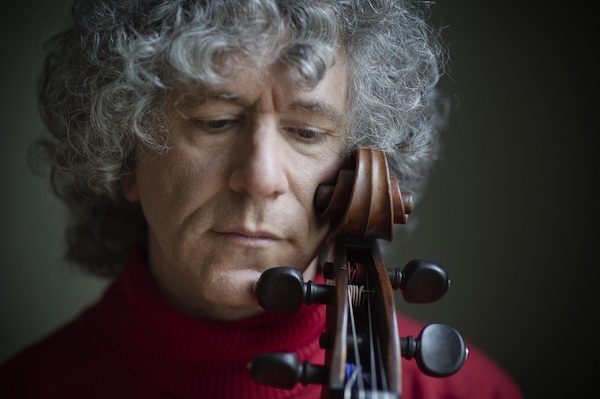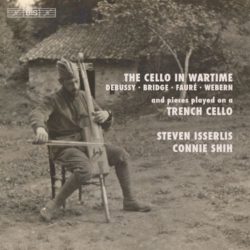Classical Music Interview: Cellist Steven Isserlis
By Susan Miron
The cellist is a member of a tribe of fabulous players/singers who are funny, thoughtful, opinionated, brilliant, and irreverent.
 Two months ago, I reviewed a CD featuring cellist Steven Isserlis and pianist Olli Mustonen. How could I have suspected that hearing this album would lead me to purchasing an armful of his other CDs? They included The Complete RCA Recordings (a 12 CD set), The Cello in Wartime (with pianist Connie Shih), the Beethoven Sonatas for Cello and Piano (with Robert Levin, fortepianist, and several others. I also looked at 3 of his books.
Two months ago, I reviewed a CD featuring cellist Steven Isserlis and pianist Olli Mustonen. How could I have suspected that hearing this album would lead me to purchasing an armful of his other CDs? They included The Complete RCA Recordings (a 12 CD set), The Cello in Wartime (with pianist Connie Shih), the Beethoven Sonatas for Cello and Piano (with Robert Levin, fortepianist, and several others. I also looked at 3 of his books.
Isserlis is the kind of hyper-articulate musician I particularly enjoy; there is ample proof available in his many interviews on YouTube. The cellist is a member of a tribe of fabulous players/singers who are funny, thoughtful, opinionated, brilliant, and irreverent. His two children’s books are a delight: Why Handel Waggled His Wig and Why Beethoven Threw the Stew. His volume Robert Schumann’s Advice to Young Musicians: Revisited by Steven Isserlis takes the much-admired composer’s advice and gives it a modern and spirited spin.
Presented by the Celebrity Series, Isserlis is performing with his old friends violinist Joshua Bell and pianist Jeremy Denk at Symphony Hall on April 28 at 5 p.m.. They are playing a wonderful program (Felix Mendelssohn’s Trio No. 2 in C minor, Opus 66, Dmitri Shostakovich’s Trio No. 2 in E minor, Sergei Rachmaninoff’s Trio élégiaque No. 1 in G minor, and Maurice Ravel’s Trio in A minor) which they are taking on tour around the U.S. Next year, Isserlis is slated to perform composer Thomas Ades’s Concerto for Cello with the Boston Symphony Orchestra. I e-mailed Isserlis some questions about his choice of repertoire, his favorite places to perform, and his affection for Harpo Marx.
The Arts Fuse: How long has this trio been performing together? How/when did you meet each other? Have you taken one of these 10 city tours together before? Who chooses the repertoire?
Steven Isserlis: Well, Josh and Jeremy played recitals together for several years; and I heard about these from Josh, with whom I’ve been performing (and close friends) now for over thirty years. Then I met Jeremy, and we two ended up playing some recitals together, as well as some chamber music (only including two trios, however) with Josh. The idea for a tour came about when we got together to record the original version of Brahms’ B Major Trio for Sony. I didn’t realize it would be so massive, though! Well, the US is a large country … The repertoire was decided one day when I got fed up of all the vague ideas floating around and made some numerous phone-calls to the 2 Js (separately — I can’t cope with conference calls!), and we finally sorted it. It’s a long programme! Again, if I realized how huge the tour was going to be, I might have suggested going for something a bit less demanding. Oh well — It’s all wonderful music.

Cellist Steven Isserlis. Photo: Jean Baptiste Millot.
AF: When did your love for Robert Schumann begin? Was it a particular piece that sparked it? Same with Gabriel Fauré, a wonderful composer for the harp.
Isserlis: I don’t know. Maybe it wasn’t so much a particular piece as happening to pick up a volume of his letters when I was a teenager, and being smitten. What a wonderful man! And his glorious spirit shines through every note of his music; the same with Fauré. (Aside from Fauré’s harp music: I’m longing to hear Prométhée, with 13 harps at the front of the stage!)
AF: And Harpo Marx? What was it like to finally meet his son Bill? What traits, besides his smile and lovely harp playing, made you such an ardent fan?
Isserlis: Well, I find Harpo absolutely hilarious — and adorable; but perhaps it is the sense of his incredibly free spirit that makes him my absolute hero. The same with Schumann and Fauré!
AF: I liked your line that, a decade after finishing school, your calendar gave you snow-blindness. How did you weather the nightmares generated by all the competitions? How did you endure music school? What finally brought you to the public’s notice? Was it a particular piece, such as the one Tavener wrote for you?
Isserlis: I have to admit that I stole that line from an ex-student! She may have stolen it from someone else, for that matter. I never did any major competitions, because I was sure that my sort of playing wouldn’t win! My career was really made through friends — such as, yes, John Tavener, as well as Josh, Olli Mustonen, and others.
AF: How did you and John Tavener discover each other?
Isserlis: I heard about John’s music and personality from one of my two musician sisters, Rachel (a violinist — the other, Annette, is a violist). I liked the sound of him and his Russian Orthodox inspired works, so I called his publisher, whom I know already, and asked if he might be interested in writing something for me.
 AF: Can you tell us a few words about your cellos? How does one part-own a cello? Does one have visiting hours/months at a time?
AF: Can you tell us a few words about your cellos? How does one part-own a cello? Does one have visiting hours/months at a time?
Isserlis Ha ha No, for the most part I only play my old Guadagnini cello at the courses I give in Prussia Cove, Cornwall; the rest of the time it is played by my great friend David Waterman, cellist of the Endellion Quartet. But I have separate cellos for repertoire I want to play on gut and steel strings: for gut, the Marquis de Coberon Stradvarius, owned by the Royal Academy of Music in London; and for steel a 1740 Montagnana that I’m in the process of buying. I also am lucky enough to have been given a couple of fine modern cellos.
AF: Which halls are your favorites for solo and chamber music? I love Wigmore Hall; I imagine you’ve played there a lot. Also, how did the album The Cello in Wartime come about?
Isserlis: Well, the Wigmore Hall is a particular favourite — I call it my musical home. But there are many other halls at which I feel very much at home — including the 92nd St Y in NYC.
The Cello in Wartime was inspired by a conversation with the doyen of violin experts, Charles Beare, during which he mentioned that he owned a little box-like cello that had been played in the trenches during the First World War. I want to visit him in order to try it, and fell in love with its gentle, sweet sound; so we decided to plan a recording of cello music (mostly) written during WWI around it. And that also gave me a chance to record with the wonderful Connie Shih, the pianist with whom I now give the majority of my recitals.
Susan Miron, a harpist, has been a book reviewer for over 30 years for a large variety of literary publications and newspapers. Her fields of expertise were East and Central European, Irish, and Israeli literature. Susan covers classical music for The Arts Fuse and The Boston Musical Intelligencer.
